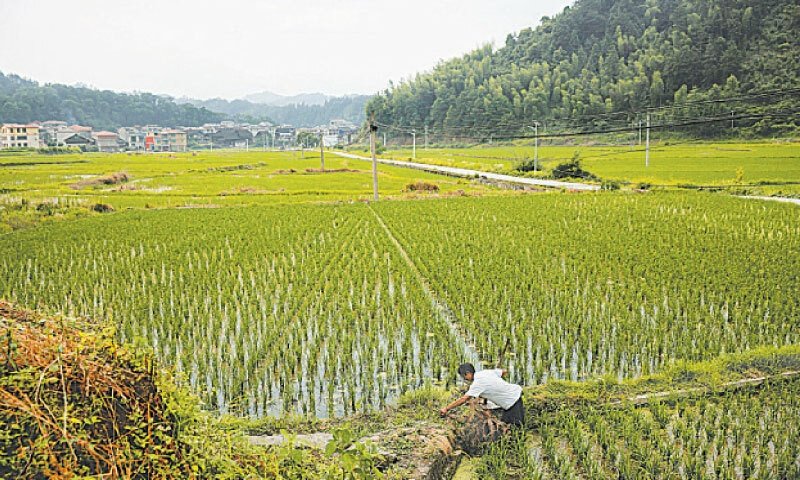Rice accounts for 2.5% of the value added in agriculture and 0.5% of GDP. It has been a major source of foreign exchange earnings in recent years.

Rice farming is a complex and challenging crop, but it is also a very important crop. Rice is a staple food for over half of the world’s population, and it is a major source of income for many farmers.
In Pakistan, rice is an important cash crop and ranks second among the staple food grains, which play a significant role in the overall national economy. Rice accounts for 2.5% of the value added in agriculture and 0.5% of GDP. It has been a major source of foreign exchange earnings in recent years.
Pakistan is among the world’s largest producers of rice, with an average production of 6 million tonnes each year. In Pakistan, modern rice varieties were adopted rather rapidly after Irri was introduced in 1968. When properly managed, Irri yielded three to four times as much as local varieties.
Among the most famous rice varieties grown in Pakistan is the Basmati, known for its flavour, aroma, and quality. Rice production comprises 40% of the basmati type and 60% of the coarse type. Rice is rich in protein as compared to other cereal crops; it also contains minerals, vitamins, and fibre.
Primarily, rice is grown in the fertile belts of Punjab and Sindh, although KPK and Baluchistan grow it on a small scale too. In Punjab, rice is grown in Sialkot, Wazirabad, Sheikhupura, Gujranwala, District Gujrat, Sargodha, Faisalabad, Kasur, Bahawalnagar, and some portions of Bahawalpur.
Besides its economic and nutritional benefits, cultivation of this vital crop comes with its own set of challenges. One significant and alarming issue is the environmental and economic impact of rice farming in water-scarce areas like Southern Punjab, especially Bahawalnagar.
While rice demands ample water for its growth, cultivating it in regions with limited water resources can have detrimental consequences for both the ecosystem and the local economy. According to an estimate, rice cultivation consumes about 30% of the world’s fresh water resources.
In water-scarce and sandy regions like Bahawalnagar, this creates a significant strain on already limited water resources. The excessive flooding of water for rice farming continuously depletes rivers, canals, and other water bodies, leading to water shortages for both agricultural and domestic use.
The reduction in water availability impacts various organisms that depend on these water sources, leading to a decline in biodiversity. The Satluj River, which is the only canal source of water for the arable land of Bahawalnagar, is continuously depleting with each passing year, affecting both biodiversity and agricultural crops drastically.
Furthermore, the excessive withdrawal of water is lowering the level of underground waters, which in the future can cause catastrophic effects.
Additionally, the flooding of rice paddies is contributing to the emission of greenhouse gases, i.e., methane, due to anaerobic field conditions created by excessive standing water, resulting in an increase in the temperature of the Bahawalnagar region with each passing year.
The Bahawalnagar region has a high risk of soil salinity and alkalinity due to rice farming, which requires an adequate water drainage system. So, in areas devoid of a proper drainage system, there are high chances of salt accumulation in the soil, which has a negative impact on crop productivity and growth.
Beyond the environmental drawbacks, there are certain economic consequences to rice farming in Bahawalnagar. As water becomes scarcer, farmers often resort to drilling deeper wells or relying on expensive irrigation systems, increasing their overall production costs and ultimately their profit margin.
To address these challenges, it is crucial to explore sustainable alternatives to water-intensive rice farming in water-scarce areas. One approach is to promote the cultivation of drought-tolerant rice varieties that require less water for their growth and development.
Another approach is the implementation of water-efficient irrigation systems such as drip irrigation or precision irrigation, which can significantly reduce water consumption in rice farming. Additionally, government policies and incentives should encourage farmers to adopt sustainable water management practises.
Last but not least, if there is no other solution available for water conservation in the Bahawalnagar region, then stop growing rice there and instead of rice farming, promote drought-tolerant crops in the region like sesame, brassica, cotton, sorghum, millet, etc. This will result in the conservation of precious water and biodiversity, depending on the water bodies. I would like to conclude my article with the words of Benjamin Franklin:
“When the well’s dry, we know the worth of water”.